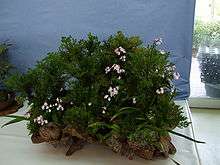Amitostigma
| 无柱兰属 wu zhu lan shu | |
|---|---|
 | |
| Amitostigma keiskei | |
| Scientific classification | |
| Kingdom: | Plantae |
| (unranked): | Angiosperms |
| (unranked): | Monocots |
| Order: | Asparagales |
| Family: | Orchidaceae |
| Subfamily: | Orchidoideae |
| Tribe: | Orchideae |
| Subtribe: | Orchidinae |
| Alliance: | Orchis |
| Genus: | Amitostigma Schltr. 1919 |
| Species | |
|
See text. | |
Amitostigma is a genus in the orchid family (Orchidaceae).[1] It is an exclusively Asian genus of 28 orchids, growing in the alpine habitats of China, Japan, Korea, Vietnam, Thailand and the Kuril Islands.[2] Twenty two species of this genus grow in China.[3]
Amitostigma are dwarf terrestrial orchids, including some myco-heterotrophic species. The globose or ovoid tubers (1 to 1.5 centimetres) of these autotrophic plants are fleshy and not lobed, with several slender roots. New shoots grow each tuber.
The stem is usually erect, with one (or rarely two or three) basal or cauline (stem) leaves. The length of the stem can vary between 5 and 45 centimetres.
The green leaf blade is not articulate and can have an oblong, lanceolate, elliptic, or ovate form, even within the same species (see A. lepidum). The leaves appear at the time of expansion of the flower (anthesis).
The terminal inflorescence is racemose, seldom subcapitate. The floral bracts are often lanceolate. The cylindrical to fusiform ovary is resupinate (turned upside down).
Each inflorescence shows many (rarely one or two) flowers. These are also resupinate and usually twisted to one side.
The sepals are completely separate from each other, with an oblong to ovate appearance, and usually singly veined. The erect petals are straight, often slightly broader than the sepals. The three- or four-lobed lip is usually longer and broader than the petals and sepals, spurred at the base. The mid-lobe is oblong, square, or ovate. The margin of the lip is often slightly undulate.
They have a characteristic short column. The erect anthers are cohesive with the column through its broad base or back. They have two parallel locules with farinaceous, sectile pollinia. The small rostellum is beak-shaped, attached with its folded end to the viscidium. The two protruding stigmas are slightly club-shaped.
The capsule is suberect.
The color may vary within the same species: Amitostigma lepidum may show a purple lip with white margins, or a white lip with purple dots or a totally white lip. Even the leaves may vary from lanceolate to ovate within the same species.
After flowering, the leaves turn yellow color and die off. The plants then starts its summer dormancy for several months. This cycle is well adapted to a climate which is hot and dry in summer.
Species
Species recognized as of May 2014:[2]
- Amitostigma alpestre Fukuy. (1935) - Taiwan
- Amitostigma amplexifolium Tang & F.T. Wang (1936) - Sichuan
- Amitostigma basifoliatum (Finet) Schltr. (1919) - Sichuan, Yunnan
- Amitostigma bidupense (Aver.) Aver., Turczaninowia 13(2): 19 (2010) - Vietnam
- Amitostigma bifoliatum Tang & F.T. Wang (1936) - Sichuan, Gansu
- Amitostigma capitatum Tang & F.T. Wang (1936) - Sichuan, Hubei
- Amitostigma dolichocentrum Tang, F.T. Wang & K.Y. Lang (1982) - Sichuan
- Amitostigma faberi (Rolfe) Schltr. (1919) - Sichuan, Yunnan, Guizhou
- Amitostigma farreri Schltr. (1924) - Tibet, Yunnan
- Amitostigma gonggashanicum K.Y. Lang (1984) - Sichuan
- Amitostigma gracile (Blume) Schltr. (1919) - Japan, Korea, Anhui, Fujian, Guangxi, Guizhou, Hebei, Henan, Hubei, Hunan, Jiangsu, Liaoning, Shaanxi, Shandong, Sichuan, Taiwan, Zhejiang
- Amitostigma hemipilioides (Finet) Tang & F.T.Wang (1936) - Yunnan, Guizhou
- Amitostigma keiskei (Finet) Schltr. (1919) - Japan
- Amitostigma keiskeoides (Gagnep.) Garay & Kittr. (1985) - Vietnam
- Amitostigma kinoshitae (Makino) Schltr. (1919) - Kuril Islands, Japan
- Amitostigma lepidum (Rchb.f.) Schltr. (1919) - Kyushu, Ryukyu Islands
- Amitostigma monanthum (Finet) Schltr. (1919) - Tibet, Gansu, Shaanxi, Sichuan, Yunnan
- Amitostigma papilionaceum Tang, F.T. Wang & K.Y. Lang (1982) - Sichuan
- Amitostigma parciflorum (Finet) Schltr. (1919) - Sichuan, Chongqing
- Amitostigma physoceras Schltr. (1924) - Sichuan
- Amitostigma pinguicula (Rchb.f. & S. Moore) Schltr. (1919) - Zhejiang
- Amitostigma simplex Tang & F.T. Wang (1940) - Sichuan, Yunnan
- Amitostigma tetralobum (Finet) Schltr. (1919) - Sichuan, Yunnan
- Amitostigma thailandicum Seidenf. & Thaithong (1997) - Thailand
- Amitostigma tibeticum Schltr. (1924) - Tibet, Yunnan
- Amitostigma trifurcatum Tang, F.T. Wang & K.Y. Lang (1982) - Yunnan
- Amitostigma wenshanense W.H. Chen, Y.M. Shui & K.Y. Lang (2003) - Yunnan
- Amitostigma yuanum Tang & F.T. Wang (1940) - Tibet, Yunnan
References
- ↑ Schlechter, Friedrich Richard Rudolf, 1919. Repertorium Specierum Novarum Regni Vegetabilis, Beihefte 4: 91–92
- 1 2 Kew World Checklist of Selected Plant Families
- ↑ Flora of China v 25 p 124, 无柱兰属 wu zhu lan shu, Amitostigma
| Wikimedia Commons has media related to Amitostigma. |